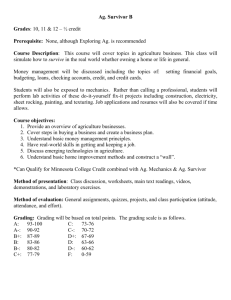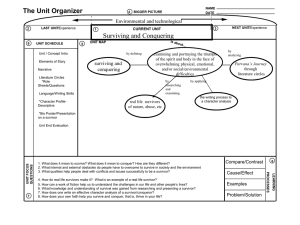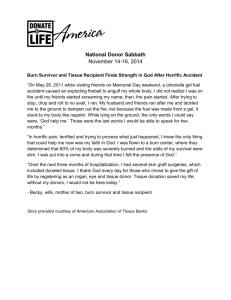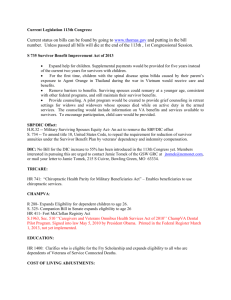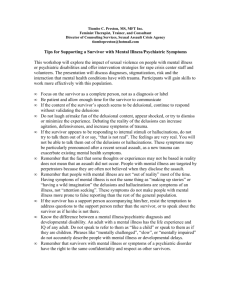Determining ThePercentages Of Responsibility Technique
advertisement
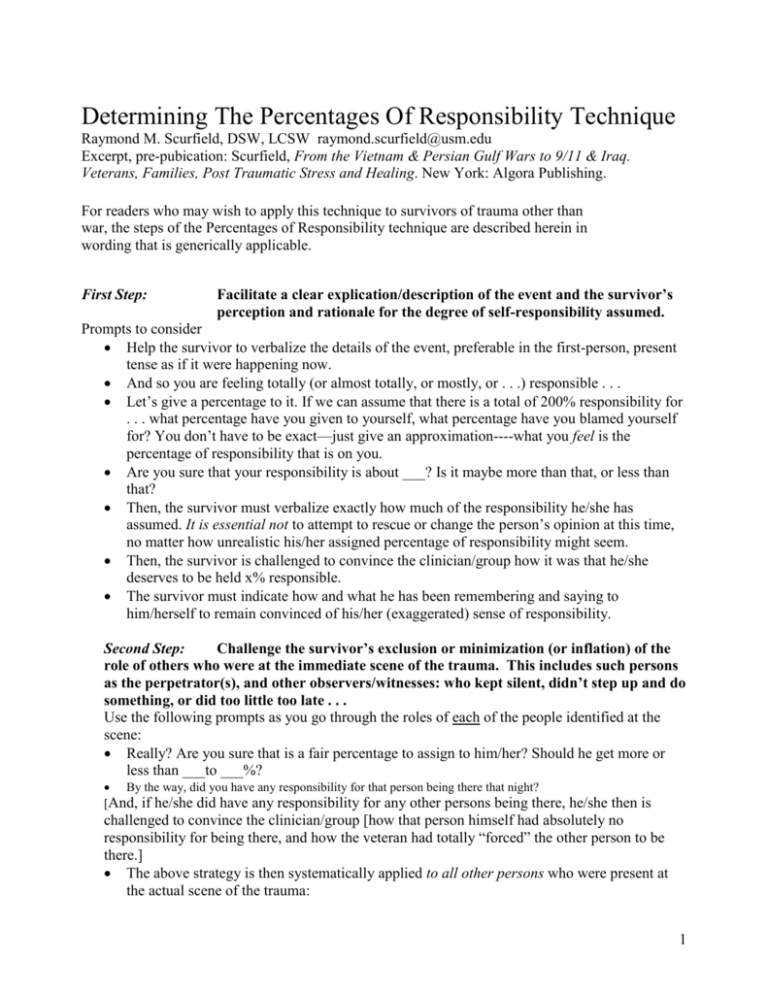
Determining The Percentages Of Responsibility Technique Raymond M. Scurfield, DSW, LCSW raymond.scurfield@usm.edu Excerpt, pre-pubication: Scurfield, From the Vietnam & Persian Gulf Wars to 9/11 & Iraq. Veterans, Families, Post Traumatic Stress and Healing. New York: Algora Publishing. For readers who may wish to apply this technique to survivors of trauma other than war, the steps of the Percentages of Responsibility technique are described herein in wording that is generically applicable. First Step: Facilitate a clear explication/description of the event and the survivor’s perception and rationale for the degree of self-responsibility assumed. Prompts to consider Help the survivor to verbalize the details of the event, preferable in the first-person, present tense as if it were happening now. And so you are feeling totally (or almost totally, or mostly, or . . .) responsible . . . Let’s give a percentage to it. If we can assume that there is a total of 200% responsibility for . . . what percentage have you given to yourself, what percentage have you blamed yourself for? You don’t have to be exact—just give an approximation----what you feel is the percentage of responsibility that is on you. Are you sure that your responsibility is about ___? Is it maybe more than that, or less than that? Then, the survivor must verbalize exactly how much of the responsibility he/she has assumed. It is essential not to attempt to rescue or change the person’s opinion at this time, no matter how unrealistic his/her assigned percentage of responsibility might seem. Then, the survivor is challenged to convince the clinician/group how it was that he/she deserves to be held x% responsible. The survivor must indicate how and what he has been remembering and saying to him/herself to remain convinced of his/her (exaggerated) sense of responsibility. Second Step: Challenge the survivor’s exclusion or minimization (or inflation) of the role of others who were at the immediate scene of the trauma. This includes such persons as the perpetrator(s), and other observers/witnesses: who kept silent, didn’t step up and do something, or did too little too late . . . Use the following prompts as you go through the roles of each of the people identified at the scene: Really? Are you sure that is a fair percentage to assign to him/her? Should he get more or less than ___to ___%? By the way, did you have any responsibility for that person being there that night? [And, if he/she did have any responsibility for any other persons being there, he/she then is challenged to convince the clinician/group [how that person himself had absolutely no responsibility for being there, and how the veteran had totally “forced” the other person to be there.] The above strategy is then systematically applied to all other persons who were present at the actual scene of the trauma: 1 Once convinced that the survivor has considered all others who were there, he/she is again challenged (without worrying if the numbers add up to 100%) to make sure that he has applied the proper (in his own mind) amount of responsibility to each of them for what happened and didn’t happen there involving that event. Now, let’s add up the % of responsibility for each person present (typically, it will be discovered that the total is well over 100%). The survivor is then confronted with this impossibility, since the total can only = 100%. Do you think that you need to reevaluate some or all of the percentages you have assigned? Is yours still x%, which means that all of these other people split up the remaining ___%, yes? Challenge the survivor’s exclusion or minimization of the indirect responsibility of others were not at the immediate scene of the trauma Are there any other people who deserve some share of the responsibility for what happened that day? Are there others who directly or indirectly had something, anything, to do that influenced the event ever occurring in the first place, or who had some influence on what happened that day? Do any of the following have any degree of responsibility whatsoever for what happened to you that day—or who have any degree of responsibility such as for supporting or ignoring, the war . . . What about the public news media (television, radio, newspapers, magazines) that often may pays much more attention to what news that “sells” the best and attracts the most viewers— at the expense of really critical moral and social issues about what is really going on. What about the entertainment industry that tends to glorify and glamorize war, and downplay the horrific nature of it? What about our country, our society, John Q citizen: who go along with spending billions of dollars on new military weapons and maintaining a defense industry that dwarfs the military threat of any other country in the world---and who cut social programs first and threaten to rescind on our nation’s long-term promise to our retired military! Third Step: Re-challenge the survivor’s sense of his/her own percentage of responsibility for behaviors and consequences regarding the trauma Now, let us return to you and what you did and did not do, and how much responsibility you had for being in the military in the first place, for being there that day, for what you did and did not do there that day? Because you were there, you did ____ and did ____ and did ____. And so, we are not here to try and explain away any of whatever percentage of responsibility you truly believe and feel that you deserve for what happened that night—once you have fully considered all the others who deserve some responsibility, too. And so, considering all the other factors and people both there and not there, what piece of the responsibility for ____ do you now believe is yours? Fourth Step: Challenge the survivor to consider if he/she has been “punished” enough for his/her personal share of the responsibility for what happened Now, tell me (us) how much you have suffered and punished yourself all these years over the ___% or so of the responsibility that you had blamed on yourself for what had happened. In other words, take into account all the times you have suffered pain from remembering and agonizing over what happened, criticizing yourself, feeling guilty, screwing up your relationships, etc., because you were feeling so bad or so unable to forget? How much? Fifth Step: 2 The clinician/group then discusses the degree of responsibility the person has now assigned internally, and how this percentage compares with the self-punishment suffered (which has been based on a much higher assumption of responsibility). The survivor must now make a very clear, forceful statement to the clinician/group about if he has concluded whether he has engaged in (self-punishment, or been punished) “enough,” “not enough,” or “more than enough—in comparison to his/her newly assigned percentage of responsibility. (It is often helpful to have the survivor repeat this statement to several individual group members.) Explicates a non-self-destructive plan to provide additional “payback” for one’s share of the responsibility The survivor is now challenged, again, to conclude if he/she “has been punished enough” or “has suffered enough” or “his/her family has suffered enough” for his/her percentage of the responsibility. If he/she has the slightest indication that he is not absolutely convinced that he/she has been punished or suffered enough, the client is facilitated to develop a non-selfdestructive, “healthy” pay-back plan. This is a plan that provides additional payback through its positive, quality-of-life sustaining, proactive stance, rather than through a self-destructive, reactive stance. This significant reframing process will require considerable readjusting of cognitions, feelings and memories. Sixth Step: Seventh Step: Conceptualize and commit to a homework assignment It is recognized that the survivor has just gone through a relatively quick process in which he/she almost surely has come to a substantially different perspective of his/her guilt regarding the trauma that has been bothering the survivor for months, years or decades. Naturally, the survivor will be full of an array of thoughts and feelings and memories, and will need some time to review, revise and consolidate his/her thinking and conclusions. To this end, the survivor is now facilitated to: think about taking time at home to reflect on what has been discussed today, and truly take into account the full circle of persons and circumstances involved: was anyone missed who should be included, or anyone included who should be excluded from having any responsibility? review and re-calculate (if that seems appropriate) the set of percentages he has assigned to various people to insure that they add up to 100%, and begin to develop an initial longer-range plan to provide additional pay-back, if any, that he/she feels & believes he must still provide—to include any specific steps & a time-table needed to undertake the positive, life-promoting payback plan. Eighth Step: End the session in a way that recognizes and confirms: what of importance has happened today? the strength and courage of the survivor to have been willing to go through this process today and how this may have impacted on you the clinician and group members (if conducted in a group). END 3
